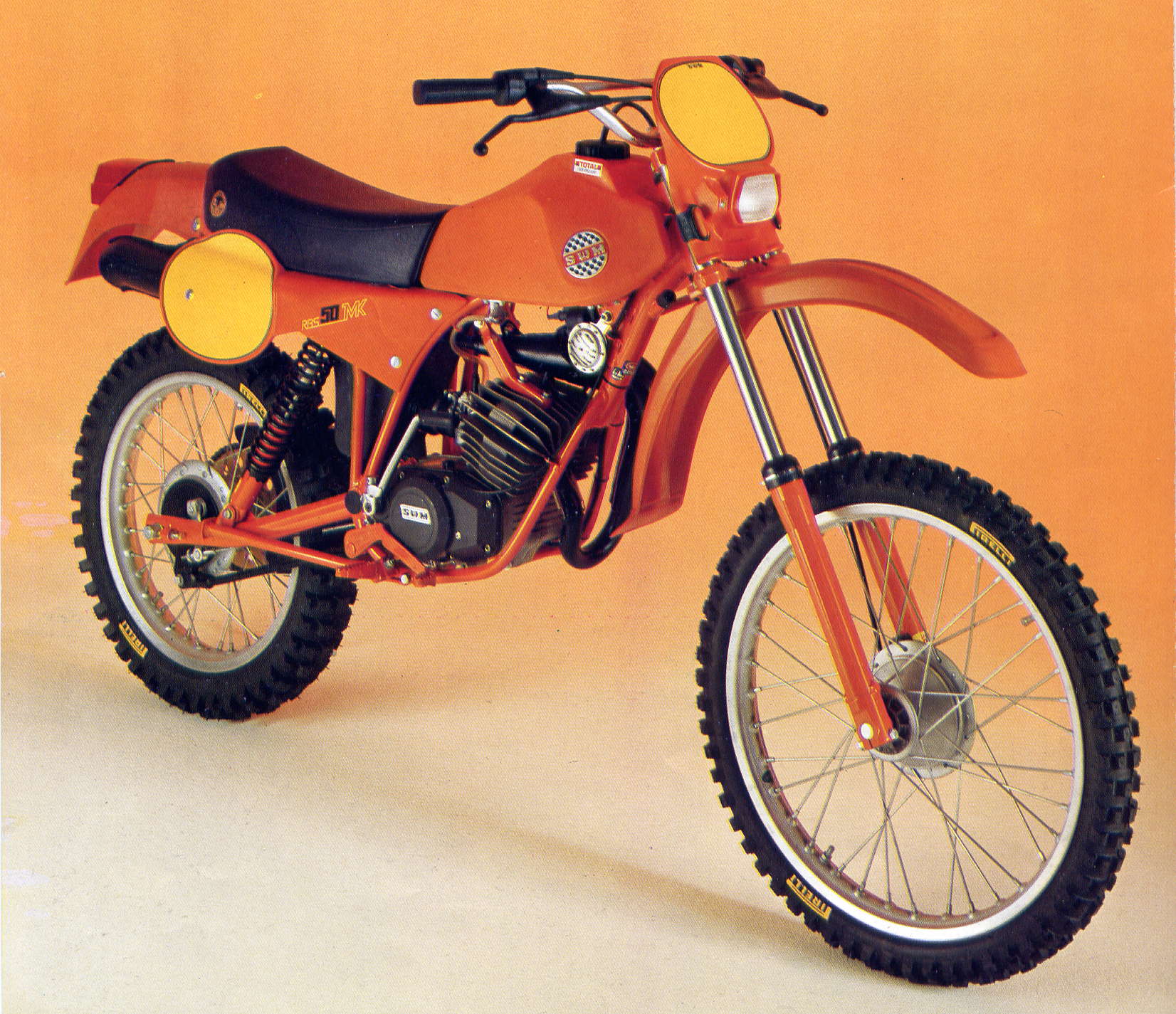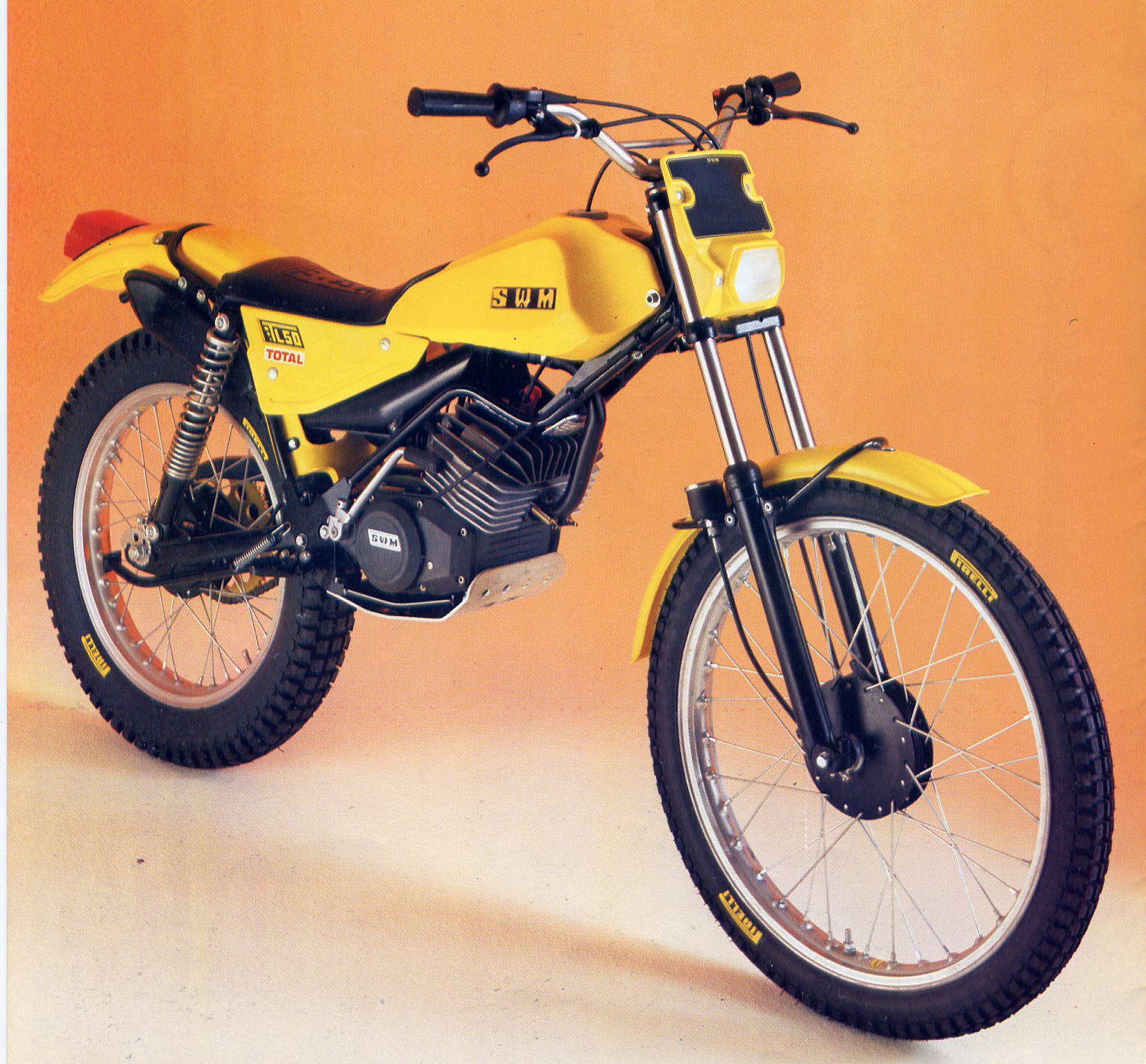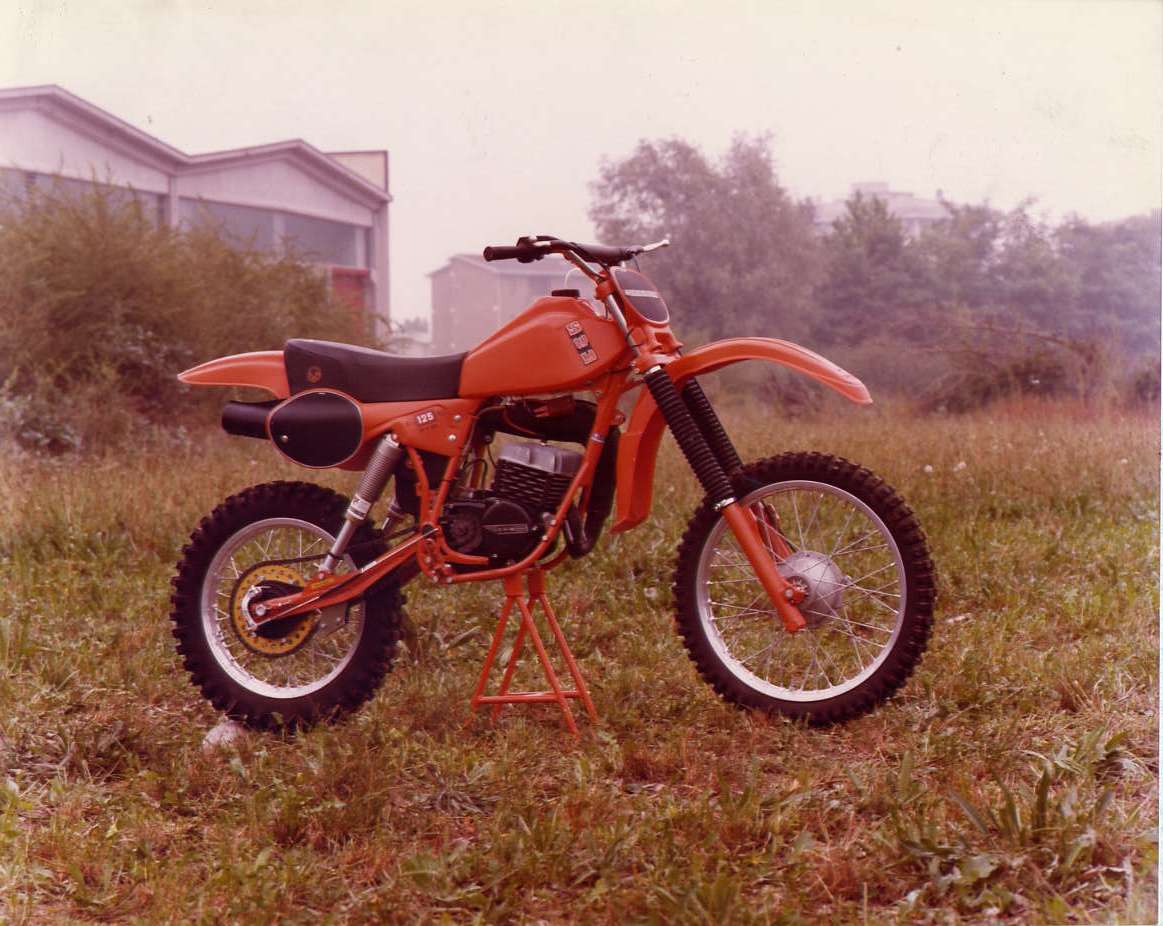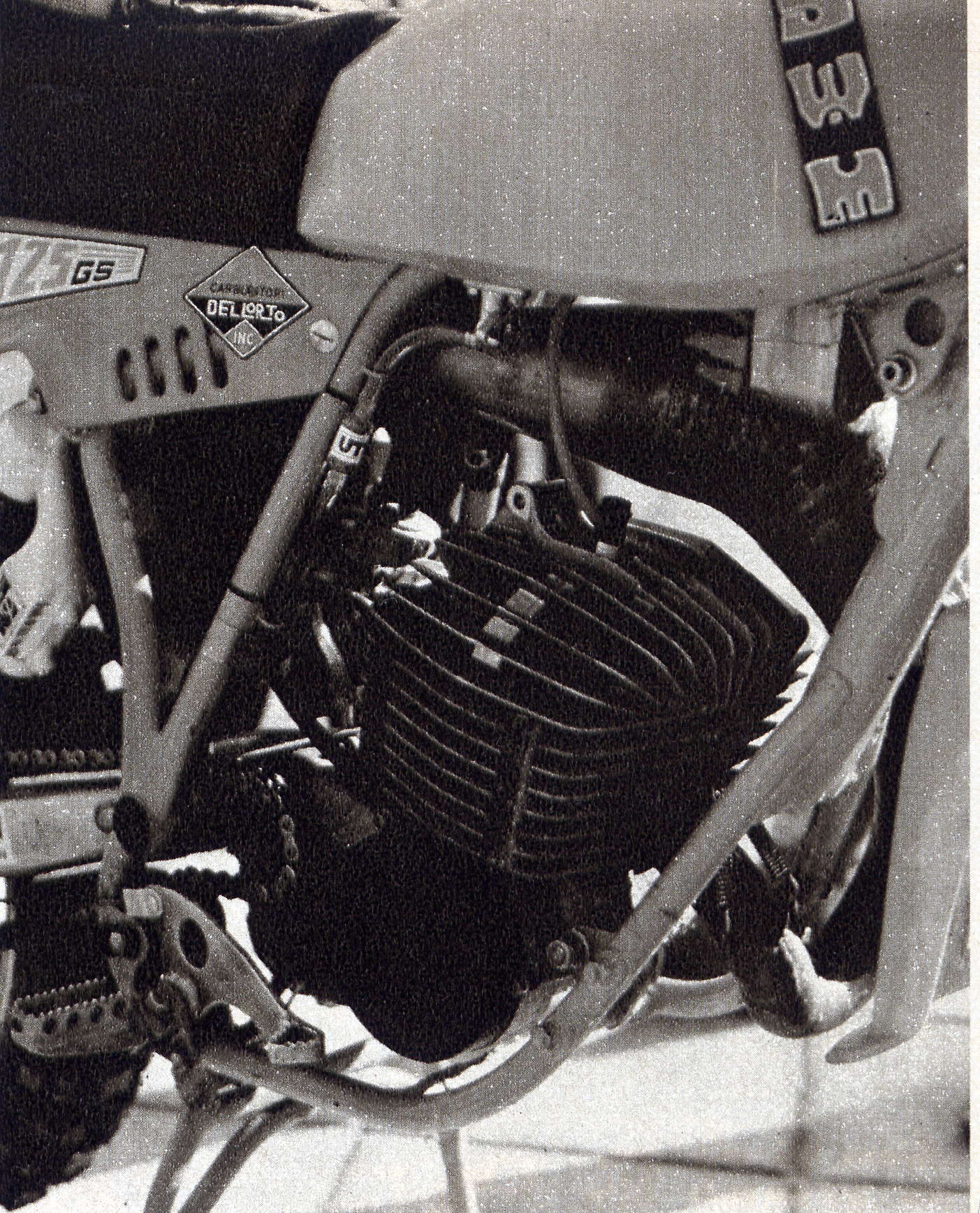SWM HISTORY 5





In this chapter we speak about history of SWM during the 1981 that was banner of more renewals in the fast growth of motorcycle firm of Rivolta d’Adda with strong renewals both within commercial and in the producing one and in the sports one.
Stylistically were revised the TF1 models of reliability and the TLN models of trial, were also included some novelties in the minor cilindrics with the entrance in production of the trial 50/80 and of the regolaristic MK 50/80. The TF1 produced in the cilindrics of 125, 175, 240,250, 280, 347, 370 and 440, were revised in the colouring that became completely orange ( like on the TF2 cross models of 1980); the fuel tank made in plastic had incorporated the drawer tool case and the cover was fixed by an elastic 3 cornered (Y) fitted with automatic bolts of anchorage, the saddle had a new design more squared, the former mudguard was embellish with a big grid of aeration to improve the cooling of the motor. Also to the cyclistic were made some improvements the posterior suspensions passed from the starting Corte and Cosso shock absorbers with splitted bowl to the most recent Compact. The undercarriage suffered a series of small changes from 1979 to 1981. Initially the former cradle had a division that joins to the central upright with a curvature like on the old RS-GS, after the junction became straight with two cut a slice of salami tubes; in 1981, the former junction of the motor was not very hard but was assured by two plates made in aluminium. Finally, the section of the tubes was slightly decreased. On the staple the old eye made in plastic, driving chain, was replaced by a new one more bigly, made in rubber and reinforced by a plate in aluminium.
The cross versions in 1981 were modified in the undercarriage adopting a new staple made in aluminium with two arms formats by two printed shells and welded at two big plates that acted also as junction for the posterior wheel. These new models were named TF4 and of series were also equipped with new Compact shock absorbers and were produced in the 125, 250, 440 ecc cilindrics. Also the trial models, produced in the 125, 240 and 320 cilindrics in the TLNW, GARA (without wiring, former number box and posterior mudguard without light) and motorcycle touring TL MNW versions, underwent an updating in the superstructure adopting a new fuel tank made in plastic material and a new saddle completely printed in foam material. The GTS Racing of 125 and 320cc were flanked by a new version named “ECOLOGICA”: all painted in military green, with all particulars, first chrome painted in black and with the logo of the “FEDERAZIONE ITALIANA DELLA CACCIA” (Italian federation of hunting) by virtue of a concluded agreement.
The greatest effort of SWM for 1981 remain however addressed to the renewal of the motorcycles of smaller cylindrical: churning simultaneously a new product of 50 and 80cc both for the trial and for the reliability in the code and competition versions. By now became old and exceeded the first mopeds of the Silver Vase and Boy series, was thought to new gained since that time; was born the most beautiful undercarriage that SWM had ever used it in the competition version was a real bicycle; where you put the wheels it remained, it is a pity that in SWM do not have time to use it in some competitions of high level and in official.
The new motorbike was produced with the same undercarriage in the versions: code MK 50 RBS-MK 50-80 GS and cross MK-80 MC.
Accordingly ranged the engines that, in the case of the code one was a radial Minarelli P6 with carburettor of 14mm, whereas in the other version they utilized some P6 short race and carburettors by Dellorto PHBH-BS of 26mm for the GS50, of 18mm for the MC50 and of 30mm for the MC and GS 80.
Further, to the end of the year, were mounted also the last version of the competition P6 with the water cooled, head and radiator put under the fuel tank. Also for the discharged were adopted some different expansions as models: the silencers were identical for the endurance models, whereas in aluminium. The suspensions ranged as models: on the RBS was mounted a Marzocchi’ staple of 32mm centre-pivot and a couple of shock-absorbers A73 by Marzocchi, on the GS models, instead, on the fore carriage was mounted a new feather staple by Marzocchi of 32mm leading-spindle and the shock-absorbers by Corte and Cosso of the compact series but of the TF1. For all the models were also utilized some wheels with rims by Akront green stamp, hub bearings of 125mm and the posterior also floating.
Regarding the new fifty trials should be said that was all an up hill road to realize it, because it was an absolute novelty in the SWM house and however, seeing the final result, the technicians of the experience department made an excellent work.
Stylistically reassembled the motorbikes of bigger cilindrics but more slender and of a more compact dimension; the absolute novelty were the undercarriage with a double cradle structure but didn’t passed under the motor but wandering it top and the propeller derived from the radial P6, specially developped by SWM that initially had also the exclusive.
The motor was literally hang up on the undercarriage by a posterior spider, pivots with the staple for the head; under the propeller was housed a big buffer plate in aluminium. Electronic ignition, carburettor of 14mm for the 50cc and 18mm for the 80cc in addition to an expansion pot with a special flat-profile silencer completed the thermal part. Like suspensions, we can find on the back two Marzocchi shock-absorbers A73 and formerly a new staple leading-spindle by Marzocchi of 30mm.
On the wheels were mounted some Akront rims, tallow stamp and hubs of 115mm cylindrical in the rear, operated by sheathed wire.
Excellent was the model of 80cc that, to that of the few whom had the possibility and the lucky of use it, was a real delicious must as it offered the agility and the lightness of the 50cc with that little more of motor that made the difference.
Not least the series of motorcycles for the children: Mini Cross and Cross Boy that were completely revised in the colouring and in the graphics that recalls that one of the RS-GS white/red.
Strong of the obtained results since that time, SWM stipulated from the 1980 some contracts of sponsorship and of collaboration for the first equipment with one of the most important firms of the sector like TOTAL, ACERBIS plastic, DOMINO, CHIARAVALLI, the REGINA chains, PIRELLI, DELLORTO, COLUMBUS; in addition to others sponsors like ABC tools, CLUB FRANCESCO CONTI and TRIGANO. Thanks to these sponsorships, for the 1981, SWM organized a race team fiercer, pointing very high in the trial, confirming like first guides GALEAZZI, BOURGAT and LAMPKIN. In the reliability the team was completely renewed with the coming of BETTONI in the 125, MEDARDO in the 175, GUALDI F. for the 250 and G.A. CROCI in the 500, in addition to follow in a particular manner the many importers whom organized some own teams committed in the National and European Championship. In particular, the SWM France counted between his riders, two promising guys, the first one was GILLES LALEY for the reliability and the second was TIERRY MICHAUD for the trial.
At the end of the season the results were beyond all expectation as SWM won the Trial World Championship with Gilles Bourgat riding a 320 TLNW, winning also the absolute primacy as Italian firm that won the coveted title always of Iberian hegemony. In addition to the World Championship in 1981, SWM won also the France Championship with Bourgat, the Swiss one with Barnafaller, the Italian one with Galeazzi, in addition to the absolute victory of Bourgat, Galeazzi, Lampkin. In Italy, even the coupled Kuciukian- Trentin won the Sidecar- Trial Championship.
Switching to reliability in the European Championship, Croci and Medardo came seconds, Gualdi third and Bettoni fifth. In the Italian Championship Medardo came first, Gualdi and Croci seconds, Bettoni seventh; in the Italian Cadets 175cc Championship, SWM came first thanks to Stefanoni. At the Six Days of the Elba Island Italy won yet another Trophy with a mixed team composed by three pilots of SWM, Croci with the 440, Gualdi with the 250 and Medardo with the 175, also the riders whom had started with a SWM motorbike in that occasion were 46 and the came were 41 winning 17 gold medals, 22 silver medals and 2 bronze medals. For what concerned the cross SWM in 1981 exclusively in the World Championship of 250cc confirming Laquaye who came seventh. An absolute novelty was the coming of SWM in the world of the kart and of the speed, providing the motor of 125cc rotary valve to many teams; at the end of the season, Baron won the Kart European Championship and in the speed, Karl Fluher came between the first of the German Championship.
In technical in the 1981 were tested many solutions both in the undercarriage and motor field above all addressed to trial sector.
In the latest two years the greater effort of the experience department and, consequently the race department, was addressed to the development of the trial motorbikes properly awarded with the victory of the World Championship, but of the expense of the other disciplines that needed in that time of a renovation of the machines.
Starting from the basis of the motocross TF4 in SWM they work on the preparation of a new endurance motorbike, at the end of 1980 with the entry into organic of a new race team SWM started the test of the new motorbikes that initially they utilized an undercarriage that differed from that of the cross for the presence of the easel, of the tail for anchoring of the posterior mudguard of reliability and for the adoption of a staple made in aluminium slightly different. The suspensions included a staple by Marzocchi, pivot axis of 35mm by Piffero and 2 shock-absorbers by Marzocchi AG6. the superstructure were made in orange plastic with electrical plant, exhaust silencer and the now undergo tests and powerful motors by Rotaxin the cilindrics of 125, 175, 250, 347 and 370. the only sour not of the series was the 125 that by now had been passed by the competition by the competition seeing that the technique was directing on more modern propellers with reed suction that offered more possibilities of development.
In this regard also at SWM and at Rotax had already left, since years, at the development of a new 125 motor with suction reed of more compact dimensions than the old project. The new motor that than would give raise to more modern motors of the 126 series (just to understand the ones used by Kramit and Aprilia), made his first public appearance in occasion of the 3^ test of the European Championship of 1981 in Spain where Bettoni brought for the first time in the competition a new motorbike slightly renewed in the undercarriage and equipped with the new motor of 125cc with small carters, (TERTA???) and cylindrical cooled still air, with radial fins joint admission to reed: in the sump pump and in the cylinder like for the 347cc. this motor underwent ulterior changes since the end of the year adopting then a liquid cooling of the cylinder that however maintained a light fins of cooling. The final evolution of the new endurance motorbikes, that were named RS-GS-TF3, occurred in occasion of the 56^ edition of the Six Days of the Elba Island where SWM sided his pilots with equipped motorbikes with a new staple made in iron rectangular section with shaped arms and junction for the shock-absorbers very advanced.
Formerly was mounted a staple by Marzocchi Piffero leading spindle of 38mm, after were built 2 shock-absorbers by Marzocchi AG6 built in a vertical position and relatively short.
Always in occasion of the Six Days SWM prepared some motorbikes for the private riders and some importers; these were some TF1 particularly well and, for whom that were members in the 125 class, SWM prepared some TF1 equipped with the new Rotax motor, lamellar liquid-cooled. In the cross, Laquaye continued the adventure in the World Championship developing in parallel new solutions including a new suspension mono-cushioning named PLB SYSTEM that provided the compression of the shock-absorbers thanks to a system of rods and richer arms.
Continuing in this rapid corporate development and feeling more the necessity of fit in new segments of the market, at SWM man start thinking seriously at street motorbikes and, like tradition, pointing the first competitions as they offered also a valid means of promoting. In this regard in the February of 1981 was entering into an agreement of collaboration with Bimota of Rimini to realize a SWM 250 twin gran prix to register in the Italian and World Championships of 1981 conduct in the competition by Loris Reggiani, engaged also in the 125 with Minarelli. SWM deals of the supply and the development of the motors whereas Bimota developped the cyclistic part. The first year served like approach to the new discipline the prospect of, officially enter the subsequent.
The structure of the new building in Rivolta D’Adda permitted to expand further the experiences department, also in function of the coming of the 47^edition of the “Ciclo e Motociclo” (International bycicle and motorcycle show), for which SWM was preparing some important novelties, like a new road motorbike of 125cc and the performance of a studying-prototype an a four-times of 500cc of by-off-road. In the big and beautiful stand in Milano, developped on four sides, SWM, as logical, publicized maximum the victory in the Trial World Championship presenting the all range from the trial 50 and 80 to the TL 125, 240 and 320 in the various models and putting on display on a high dais the motorbike of Bourgat. An all side was dedicated to the presentation of the new endurance motorbikes in the version MK of 50 and 80cc of endurance GS and cross MC; the all range of RS-GS TF3 and of the cross TF6.
Another side was dedicated to the mopeds, to the motorbikes for the children and the code mopeds, with a new version of the Regolarità Boy 50 revisited in the superstructure and in the colouring white/red like on the first RS-GS; in addition to the new MK 50 RBS.
The last side was dedicated to the scrambler Racing 125 and 315 renewed in the graphic; a large space was also dedicated to the presentation of a new 124 RZ road and to the dummy of stylized four-times of 500cc.


